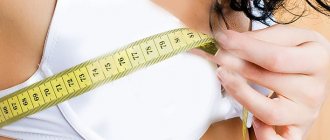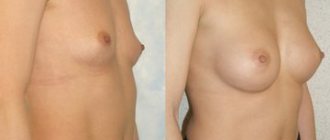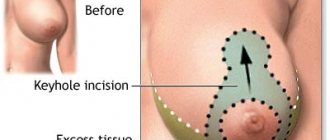During puberty, a teenager's mammary glands begin to grow. But they don’t immediately become large, so parents begin to think about how to enlarge a teenager’s breasts. There is no need to start worrying, because at 10 years old there is still little glandular tissue. But over the years, over the course of eight to ten years, the process develops intensively, and by the age of twenty, the girl’s bust will be completely formed.
Physiological breast growth in girls
It is first discovered that the mammary glands begin to grow at 10–11 years of age. For some, a little later - at 13 years old. Usually the appearance of small lumps is detected a year before the first menstruation. Breast growth is characterized by several stages of development. At first, a small circle near the nipple protrudes slightly. At the age of 12, the breasts acquire a conical shape, but with the onset of menstruation they become rounded.
The volume and development of the breast depends on:
- level of health of a teenage girl;
- nature of nutrition;
- hereditary genes;
- features of the constitution;
- body weight;
- child's lifestyle;
- hormonal background.
A girl will be happy with her bust if her mother also has large breasts.
Fat deposits with a large weight allow the mammary gland to become larger. Active physical exercise increases muscle mass. At the same time, the breasts are tightened, and even with a small size they look formed and voluminous.
The process of puberty, when there is a surge of hormones, affects the increase in breast size. But the formation of mammary glands occurs quickly in some, and slowly in others. It depends on the individual characteristics of each girl. You need to be patient, and not rush to use biological supplements, and smear your chest with hormonal ointments, and go to salons for vacuum massages. These procedures provide a temporary effect of breast enlargement and negatively affect the health of a 12-year-old girl.
Breasts of different sizes in a teenage girl
Starting from the age of eleven or twelve, the girl’s body “awakens” under the influence of the hormone estrogen, the production of which improves during this period. Uneven development does not become noticeable immediately, as does an incorrect position relative to the axis of the chest.
And although the first complaints about a defect appear in a teenager at the age of fifteen, final conclusions can be drawn only after the formation is completed, that is, by the age of 17-18.
Possible reasons for delayed development of one of the glands:
- hereditary hypo- or hyperplasia;
- acquired - due to injury.
It is impossible to guarantee protection of a child from any of these two factors - heredity cannot be influenced, and injuries occur even in the most careful children. And yet, the risk of bruise or even bruise with tissue dissection increases significantly if, for example, you send a girl to the gymnastics section.
What can you do if your breasts are different sizes?
It all depends on how serious the problem is. If there is a difference in volume (within the same size), practically the only way to hide the defect is to wear a bra for large breasts and use filler for an empty cup.
Stuffing your bra with cotton every day is the worst option. For this purpose, it is better to sew a soft insert made of hygroscopic fabric, possibly knitted, into underwear of a suitable size. The strong fixation of such a pad in the underwear will eliminate the worry that something might move, warp, or come out...
Models of lifting push-up bras have an ideal camouflage effect, which can be easily supplemented with their own insert by simply inserting it into an existing pocket in the cup.
If the problem is not the size of the glands, but their asymmetrical location, it will not be possible to hide this with the help of underwear: the bra “sits”, exactly repeating their uneven location.
In this case, you can only divert attention from the imperfection of the figure with the help of tricks in clothing:
- a blouse with small polka dots or another pattern will visually hide the axis tilt and asymmetry;
- diagonal stripes and a tissue scar will slightly correct the position, you just need to choose the direction of the stripes upward from the side of the lower gland;
- 60s-style fancy patterns also hide asymmetry;
- a checkered or checkerboard print, as well as strict lines and a high waist, will emphasize the defect, and therefore they should absolutely not be worn;
- Accessories such as a neckerchief, scarf, shawl collar and cowl collar perfectly camouflage the problem area.
How to correct breast asymmetry
We are, of course, talking about plastic surgery. This cannot be done in any other way, for example, massage, pills, ointments. After consultation and examination, the surgeon makes a decision to enlarge, reduce, or correct the position of one gland relative to the other, or in extreme cases, both glands at once.
You can undergo surgery only from the age of 18, although consultation on this issue is not prohibited at any age. The reason for different breast sizes is usually of no importance to a plastic surgeon, except in cases of any cancer, for which any intervention increases the risk of relapse.
Subjecting yourself to surgical intervention, especially implantation, must take into account your plans for pregnancy and breastfeeding. The healing and rehabilitation period after plastic surgery and before such a load as feeding should be at least a year.
This time is required not only to restore health after surgery, which happens, of course, much faster, but also for the mammary glands to fully adapt to the new position, for the skin and deep tissues to become accustomed to the load, and also to absolutely make sure that there is no implant rejection will happen.
Why do breasts become different sizes when breastfeeding?
A common problem for all nursing mothers is changes in the mammary glands after pregnancy and lactation. The glands may enlarge unevenly, descend to different heights, and change their shape with subtle or striking differences.
The body of a nursing woman, in contrast to her own period of puberty, is affected not only by estrogen, but also by the lactation hormone - prolactin. The attack of these two very important hormones on the mammary glands, although functioning normally, can be excessive.
Milk production, as young mothers often notice, is not the same in both glands: one produces nutrition for the baby evenly, constantly filling with milk at the same speed, the other is “capricious” - sometimes it lags behind, sometimes it overflows.
Many women are irritated and confused by this “behavior” of the breast, and they almost unconsciously give preference to the one that is easier to fill and empty.
But putting a baby on one breast, ignoring the other, is a big mistake. The consequences of milk stagnation in the gland can be serious, including mastopathy and inflammation of the milk ducts. One of the complications of this situation may be when, after the end of feeding, one gland returned to its normal size, while the other remained enlarged, as if in retaliation for being neglected.
Prevention of asymmetry after feeding is simple - alternate glands, preferably several times a day. It is also very important to express the milk that has arrived if the baby cannot empty the breast - for example, he is already full.
Breasts that become excessively enlarged or sag during breastfeeding can be corrected by resorting to plastic surgery. In this particular case, the most common solution would be an operation to reduce the size of one of the glands to normal, taking the smaller one as normal.
If breasts become different sizes during menopause
Any changes found in the mammary glands during menopause and the premenopausal period (after 45-47 years) are cause for concern. Breasts that have changed their shape should be carefully examined by the woman herself.
Then you must undergo an examination by a mammologist. Not only visual asymmetry (difference in size or degree of prolapse) should concern the patient and the doctor, but also possible thickening and curvature of the contours of the breasts and areolas around the nipples. In order not to miss a serious disease, the examination must be approached with all responsibility.
The mammary glands, like any other organs of the human body, are not exactly the same in size. If the difference is small, this is considered normal and does not require medical intervention. When one breast is one or two sizes larger than the other, such a violation negatively affects the woman’s psyche and requires examination. But such an anomaly occurs quite rarely, and most often the asymmetry of the mammary glands is associated with the period of lactation and disappears after its completion.
How to speed up breast growth at home
A girl who has a flat chest at 15–16 years old can be advised to grow her breasts:
- take a contrast shower two to three times a week, directing the stream from bottom to top to the area of the mammary glands;
- engage in sports and exercise;
- eat nutritiously, including foods containing vitamins and fatty acids in the diet;
- apply cold compresses of sea salt and warm compresses with geranium, ylang-ylang and almond oils to the chest;
- Apply mustard plasters for two to three minutes.
After compresses, be sure to lubricate the skin of the mammary glands with a softening cream.
The hormone estrogen is responsible for the fullness of the bust. You can get it from products that are used in the diet to accelerate the growth of mammary glands:
- Soy and other legumes are known to help expand the glandular layer of bust tissue.
- The effect of eating cabbage is significant when breasts are just forming. It will help a 10-11 year old girl, but it’s unlikely to help a 16 year old girl.
- Among fruits, green apples and lemon, the juice of which is mixed with boiled chicken, help to enlarge the mammary glands.
- To enlarge your breasts, it is useful to include dairy products and fatty fish in your menu.
Since many teenagers at the age of 14 begin to lose weight sharply, trying to make their figure slim, you need to know that this step will lead to hormonal imbalance.
And the girl will look like a teenage boy with a flat bust. You need to grow breasts without dieting for weight loss.
Physically strong girls also have developed pectoral muscles. Playing badminton, tennis and swimming increases breast size. Indeed, in these sports the emphasis is on developing and strengthening the muscles of the arms and chest. For girls with the constitution of a child, it is necessary to select exercises aimed at expanding the volume of the pectoral muscles. Going to the gym will help enlarge your chest. The training program includes exercises with dumbbells, push-ups and wall push-ups.
The muscles located under the mammary glands will build up. And the chest will move forward and tighten. Physical education classes will give a beautiful shape to a girl’s bust.
Among the exercises for morning exercises, choose those that are aimed at strengthening and growing the pectoral muscles:
- Leaning on the wall with the palms of your arms wide apart, try to move it with force in ten seconds.
- Lying on the floor, raise your arms with dumbbells fifteen times.
- Standing or lying down, pull your arms with dumbbells to your chest.
- Raise your arms with dumbbells above your head, reaching back.
- Bend and straighten your arms at the elbows, holding them at chest level.
- Perform circular movements with straight arms back and forth.
- Imitate breaststroke swimming while standing upright.
You can select movements individually by consulting with a trainer.
Along with playing sports, massage plays a major role in bust enlargement.
The procedure will tighten the breast tissue, stimulate blood flow in this area and accelerate the outflow of lymph. The massage technique includes:
Taoist massage is based on circular stroking of the breast gland over thirty times, due to which the hormone prolactin is produced, which is responsible for the growth of the breast area. Regular massage, in combination with water procedures, will have a beneficial effect on the growth of glandular tissue cells. An expanding bust will be a reward for your efforts.
To make breasts grow faster, use herbal infusions:
- Mallow root is used for chest compresses and oral administration. Three tablespoons are placed in water (three glasses) and boiled for fifteen minutes. The decoction is taken orally in a glass during the day, divided into three servings.
- Drink oregano herb tea twenty minutes before meals.
- A tablespoon of crushed flax seed is added to a glass of kefir or yogurt and consumed for up to a year.
- The hop cones are infused in a water bath for a third of an hour. Take it orally daily - with this drink the girl’s breasts will grow faster.
- An infusion of the herb sparkling cuff is drunk before meals. It increases the volume of the mammary glands in girls aged 15 years and older.
Masks for breast enlargement are effective when prepared from:
- grated apple and cabbage in equal proportions;
- potatoes, boiled in their skins and mashed with the addition of vegetable oil, cream and natural honey;
- blue clay, diluted with warm water to a paste;
- cocoa butter
Rub the masks into the breast tissue in a circular motion, gently. Do not lubricate the area around the nipple. Leave the mask on for ten to fifteen minutes, and then wash off with warm water, lubricating the skin with a nourishing cream.
At what age does breast growth stop?
Puberty, or the time of puberty in girls, occurs between 8 and 13 years. Throughout puberty, important changes in the reproductive system occur that are necessary to prepare for future motherhood. Depending on individual characteristics, it can last from two to four years.
At the age of 10, the mammary glands usually begin to increase in size. This process, on average, takes from five to eight years, depending on the constitution and characteristics of the body. At the age of 11, girls develop acne on the face, as well as in the chest and back. Also during this period, hair begins to grow in the armpit and pubic area.
The first critical days in most cases begin at 12 years of age. Until fully established, menstruation may be irregular, but should not last longer than five days. At age 13, changes in body shape begin, likely weight gain and the appearance of fat deposits in the abdomen and thighs. During this period, it is extremely important to pay attention to proper nutrition and sports training in order to form a beautiful figure.
In most cases, at the age of 16, the size of the mammary glands is completely formed. However, if after reaching this age your bust size still remains modest, you should not worry. In such situations, the process of breast growth can continue up to 23-25 years. A 17-19 year old girl will be helped to activate it by special nutrition, physical exercise and some herbal extracts. In addition, it should be taken into account that the most significant increase in breast size occurs during pregnancy and lactation.
There are several safe and reliable ways to speed up breast growth. Among them are special nutrition, massage and physical exercise, as well as the use of folk remedies and phytohormones.
Nutrition
The most important role in the harmonious formation of the breast is given to nutrition. All food entering the body must be natural and fresh. It is recommended to completely exclude all kinds of concentrates and additives from the diet.
In fact, this vegetable is rich in plant estrogens, which stimulate growth, but do not affect the volume of the mammary glands. Cabbage also contains vitamins and plant fiber necessary for the harmonious development of a young body. However, you should not consume this vegetable in too large quantities, as it provokes problems with the digestive tract - in particular, disorders and bloating.
For full physiological development and proper growth of the mammary glands, a girl needs to enrich her diet with natural sources of protein. These include fish and seafood, lean parts of poultry, cheese and dairy products. The most useful and recommended for increasing breast size:
- red beans, lentils, soybeans and other products from the legume family;
- brown rice, barley and oatmeal;
- sesame, olive and flaxseed vegetable oils;
- a drink made from fresh milk and papaya juice;
- orange, carrot, apple and pumpkin juices;
- avocado;
- various types of nuts.
Do not consume yeast or raw dough. These products lead to an increase in total body weight, as well as problems with well-being - bloating and diarrhea. Nutrition must be healthy and moderate. Low-calorie diets will be harmful, as they contribute to the deterioration of the natural shape of the breasts and disrupt the balance of hormones in the body. Sudden weight loss is very undesirable. For an ideal breast shape and size, a balance between fat and glandular tissue is important.
Playing sports in adolescence helps girls gain a slender posture and strengthen their chest muscles. Emphasis should be placed on badminton, tennis and swimming. There is a simple set of exercises that should be performed daily:
- With your elbows at chest level, press your palms firmly against each other.
- Standing against a wall, spread your arms wide and press your palms firmly into it. Perform movements that simulate moving a wall from its place.
- Keeping your elbows at chest level, clasp your fingers tightly and try to spread them in different directions.
- In a lying or standing position, take dumbbells in your hands and pull them towards your chest.
- Do push-ups with outstretched arms. To begin with, you can make this exercise easier by performing it against a wall or on your knees.
- Take dumbbells in your hands and lift them above your head, trying to move them as far back as possible.
- Stand near the table and turn your back to it. Rest your hands on the edge of the table, pointing your elbows back. Squat down, keeping your knees at a 90-degree angle.
- Stand up straight, simulating breaststroke swimming.
- Keep your arms at chest level, alternately bending and straightening them at the elbows.
- Straighten your arms and perform circular movements with them forward and then back.
To grow pectoral muscles, each exercise should be performed 15 times daily.
According to the famous Taoist technique, gentle stroking in a circular direction, performed more than thirty times, promotes the production of prolactin, a hormone necessary for the formation of the mammary glands.
Some plant extracts - phytoestrogens - will bring significant benefits in increasing the size and improving the shape of a teenage girl’s bust. The advantages of using them include:
- strengthening the pectoral muscles;
- normalization of hormonal balance;
- beneficial effects on the cardiovascular system.
However, plant hormones taken in too large quantities increase not only the chest, but also other parts of the body in volume - buttocks, thighs and tummy - which is very undesirable.
Phytoestrogens, or dietary estrogens, are found in the following plants:
- ginseng;
- fenugreek;
- blueberry;
- carrot;
- broccoli;
- Red clover;
- oregano;
- licorice;
- turmeric;
- alfalfa;
- hop;
- linen;
- verbena.
Folk remedies
There are many effective folk methods that accelerate breast growth:
- Oregano tea. It is recommended to drink it 20 minutes before meals.
- A decoction of mallow root is used both for internal use and for compresses.
- Infusion of mantle herb.
- Ground flaxseed (1 tablespoon), added to a glass of yogurt or kefir.
- Infusion of hop cones.
The time at which active breast growth begins is largely determined by the genetic predisposition and climatic conditions of life of the future woman. The development of mammary glands in indigenous women of hot countries begins, on average, somewhat earlier than in their peers from northern latitudes. The timing of the appearance of secondary sexual characteristics may depend to some extent on diet.
The reasons for breast growth are due to an increase in the level of female sex hormones - estrogens - in the body. And since the latter can be produced by adipose tissue, girls with a dense physique usually mature a little earlier than their thin classmates.
Female breasts form and mature over a period of 5–10 years. A girl goes through 5 stages of breast development.
Stage 1
The first stage begins at birth and lasts until 7–10 years. The chest remains flat and invisible. Areolas resemble small brown spots that are round or oval in shape. The nipples do not protrude above the surface of the skin and practically merge with the areolas.
Stage 2
The second stage begins after the ovaries awaken, at 9–12 years of age. The mammary glands become more visible and convex. The areolas increase in size, and the nipples protrude slightly above the surface of the breast.
At the second stage, the rudiments of the mammary glands appear. The small tubercles are soft but dense. They consist of connective and adipose tissue. In the second stage, milk ducts develop. The process is accompanied by mild discomfort and pain.
Stage 3
The third stage coincides with the onset of menstruation at 12–14 years of age. The amount of connective and adipose tissue increases. The chest is rounded, acquiring a more pronounced cone-shaped shape and outline. The color of the areolas becomes darker and more saturated, but the contours of the nipples may remain blurred.
At the third stage, thoracic veins form in girls. They may show through the skin, and this is normal. Also, girls at the third stage sometimes develop swelling in the area of the areolas, and the sensitivity of the nipples increases.
Pain and discomfort may increase. Especially during menstruation, when estrogen levels increase.
Stage 4
After the first menstruation, a girl’s body begins to produce progesterone. The hormone does not affect the size of the mammary glands, but makes them denser and more elastic. In the fourth stage, the breasts become rounded. Areolas and nipples protrude above the surface of the mammary glands. Their contours become clearer and more noticeable.
In the fourth stage, the skin stretches due to the active growth of the breasts, so some girls develop pink or white lines - the so-called stretch marks. Small streaks are not abnormal and do not require intervention. Stretch marks disappear by the age of 18–20, when a girl’s hormonal levels normalize and the development of the mammary glands stops.
Stage 5
The fifth stage begins after puberty, at 17–19 years of age. The development of the mammary glands slows down and stops. The breasts acquire their final shape and size. The nipples may deepen and become less protruding, and white spots called Montgomery glands form on the areolas.
Some girls have small lumps in their mammary glands. If they disappear after 2-3 menstrual cycles, then there is no reason to worry. In the fifth stage, chest pain also decreases. Discomfortable sensations appear only before menstruation. In girls, stretch marks also disappear, and the connective tissue is gradually replaced by fatty tissue.
According to numerous studies, breast growth has five stages:
- First (initial). It begins at birth and continues until the age of ten. At this time, the breasts do not yet have volume, they are flat. But if you look closely at it, you can see the milk line below the nipple. This is the boundary along which the mammary gland then develops. A few days after birth, discharge sometimes appears from it. But it doesn't last long.
- Second. This is the period from twelve to thirteen years. During this period, great changes occur. The breasts become firmer and softer, and the nipples become larger. Their skin darkens. Swelling appears in the nipple area. But this is still undeveloped breast tissue. The first signs of growth appear after changes in hormonal levels.
- Third. Begins during puberty. In girls it occurs at different ages. At this time, rapid breast growth begins. It becomes conical in shape, the top is the nipple. Then the breasts become rounded, but are still not fully formed.
- Fourth. Puberty ends, and with it the breasts are almost completely formed. It continues to grow and milk ducts develop. Feelings of itching and pain appear because the skin begins to quickly stretch. The skin on the chest becomes thinner, and a network of blood vessels is already visible through it. The breasts become mature and acquire clear boundaries of the nipples and areolas. This stage can last up to sixteen years (sometimes up to twenty or even twenty-five years).
- Fifth - pregnancy. During this period, the breasts are fully formed. But due to changes in hormonal levels, it begins to actively grow. Additional glandular tissue appears and ducts develop. The breasts change the shape of the nipples and their areolas, which then remain that way for the rest of their lives.
Stage 5
- A balanced diet that contains plenty of protein, good fats and complex carbohydrates.
- Refusal of tea, coffee, chocolate and other products containing caffeine.
- Drinking clean water in large quantities.
- Get adequate sleep and moderate physical activity.
- Quitting smoking, alcohol and energy drinks.
Hormones
A teenager’s bust is not growing – what to do?
Breast formation ends at 16-20 years of age. If the mammary glands do not begin to enlarge, then you need to make an appointment with a mammologist, gynecologist or endocrinologist.
A thorough examination and examination will reveal the causes of underdevelopment of the mammary glands. Often, due to stress and poor environmental conditions, hormonal disruption occurs and the mammary glands do not develop.
A check by specialists will reveal what hormone is missing in the girl’s body and the reasons for the underdevelopment of the glands. Only hormonal therapy will help here. But you can’t stuff yourself with birth control pills. They have many side effects and a large list of contraindications. And for teenagers, hormones are especially harmful, as they lead to various pathologies.
There is no need to rush into breast enlargement; it’s okay if a girl’s chic curves don’t show through her summer outfits. Everything has its time. If an adult woman suffers from small bust volumes, then there are more ways to increase them, and they are safe for an adult body
During puberty, many girls are embarrassed by their small bust size, which becomes the reason for the development of many complexes. However, today there are many remedies that help enlarge breasts during adolescence. To do this, you need to make adjustments to your diet and perform special physical exercises.
If the bust does not begin to grow even at the age of 15-16, you should consult a doctor - perhaps the reason lies in a hormonal imbalance.
General rules and recommendations
Basic rules that must be followed for full development in adolescence:
- proper nutrition;
- playing sports;
- maintaining personal hygiene.
There is no need to torture yourself with diets if your weight seems “too much”, since it is extremely important for a growing body to receive all the necessary vitamins and microelements.
Moreover, one of the reasons for developmental delay is poor nutrition. Because of this, breasts may also be smaller than those of peers.
Under no circumstances should you try on yourself any dietary supplements, advertised “breast enlargement” products, ointments of dubious origin, etc.
It is extremely unreasonable to carry out a vacuum massage at 14 years old (besides, no normal salon will work with such a client) or to carry out warming procedures (for example, applying mustard plasters to the chest).
If there is an effect, it will only be temporary. After completing the course, the glands will return to their previous volume, unlike health problems, which are not so easy to get rid of.
For girls at 15, 16, 17 years old, the foundation for the health of the body is laid, so any experiments can be very dangerous.
Women's health is a fragile thing, so you need to take care of its preservation from adolescence.
Nutrition
You can find recommendations for taking special foods that accelerate the growth of the mammary glands, but you shouldn’t rely too much on such a diet.
You need to eat fresh and natural food, and exclude all additives and concentrates.
There is a common myth about raw or pickled white cabbage, which supposedly enlarges the breasts without any effort, especially in adolescence.
There is some truth in this statement, namely that the phytoestrogens contained in cabbage actually accelerate the growth of glands.
The emphasis is on what exactly accelerates growth, but does not increase volume.
Doctors treat this recommendation with a smile.
The abundance of vitamins, fiber and other important components that make up cabbage will undoubtedly benefit the young body. However, you should not pin all your hopes on this product.
If nature has programmed you to have a breast size of 2-2.5, cabbage is unlikely to help here. You also need to know that consuming large quantities of vegetables can cause bloating and stomach upset.
List of products that promote full physiological development:
- beans (lentils, soybeans, red beans);
- cereals (oatmeal, barley, brown rice);
- vegetables, fruits (lettuce, peppers, tomatoes, citrus fruits);
- fresh juices (apple, orange, pumpkin, carrot);
- vegetable oils (olive, sesame, flaxseed);
- nuts;
- sea fish;
- avocado;
- a mixture of papaya juice and milk (daily consumption of the drink accelerates the growth of glands).
The diet must include fermented milk products, seafood, lean poultry (chicken, turkey), and cheese. These are sources of protein.
A healthy, balanced diet has a positive effect on breast formation in teenage girls. Fads for all sorts of diets have the opposite effect.
Severe weight loss leads to a reduction in the glands, since in addition to glandular tissue they also consist of adipose tissue.
Poor nutrition not only worsens the shape of the bust, but also disrupts hormonal levels. Therefore, if you want voluminous breasts, you will have to give up low-calorie diets.
There are also foods that should never be consumed for breast enlargement.
This is fresh and compressed yeast, which “experts” advise eating to grow a bust. The minimum that can be achieved is an increase in body weight. Complications such as bloating and diarrhea are also possible.
For the same reason, you should not eat raw dough.
Features of physiology
The mammary glands begin to develop during puberty. Most often, the first manifestations of breast enlargement are observed at 10-11 years of age. But for a number of girls this happens later – at 13 years old. Most often, the bust begins to increase a year before the start of menstruation.
Breast development usually takes 3-5 years, but for some girls this process continues much longer. As a rule, the development of the bust is completed at the age of 15-16, but some girls find that this process is delayed until the age of 19-25.
That is why the popular question of how to enlarge a bust at 13 years old is not considered relevant. You shouldn't expect a major change in size at 15-16 years old. However, it is still possible to slightly enlarge your breasts.
Why and what to do if one breast is larger than the other
Most girls' breasts are not symmetrical. If the difference is small, then it does not cause discomfort. With a significant difference in shape and size, the girl feels, at a minimum, embarrassment from the aesthetic appearance. A change in breast symmetry can be observed at different periods of a woman’s life. Let's figure out what is normal and in what situations you should visit a doctor.
Basic methods of enlargement
Women's breasts are approximately 85% fatty tissue. Therefore, the main method of increase is weight gain. Thanks to this, the breasts will get better, which means their size will increase. To achieve such results, it is enough to increase the calorie content of your diet.
Another reason for insufficient breast size in adolescence is considered to be an imbalance of hormones. In this case, the girl’s body produces too little estrogen, which helps to enlarge the breasts. At the same time, too much testosterone is produced, which interferes with the development of the bust. In such cases, hormonal drugs are usually used, but only a doctor should select them.
Exercise cannot enlarge breasts because they do not involve muscle tissue. With the help of sports, it is possible to build up the muscles that are located under the bust. Thanks to their strengthening, the breasts move forward a little, which makes them more toned. Also, regular exercise has a positive effect on posture, which improves the appearance of the bust.
Massaging your breasts is very beneficial. This should be done three times a day for several minutes. Thanks to this, it is possible to enlarge the bust, since the procedure normalizes blood circulation and promotes the supply of nutrients to the mammary glands.
What to do if one breast is larger than the other: correction methods
Before prescribing correction of breast asymmetry, the doctor must identify the cause. So if the asymmetry is caused by feeding the baby, then lactation adjustment is possible. This will help avoid surgery.
If there are tumors that affect the size of the mammary gland, they are surgically excised. Other cases of differences in breast size and shape are corrected through plastic surgery.
Preparing for breast surgery
First of all, a consultation with a breast surgeon and/or a plastic surgeon is necessary. Next, the doctor listens to the patient’s preferences and the result she would like to see from the operation.
The next step is a breast examination. The doctor measures the size and explains the nuances that explain the asymmetry.
After discussing the operation, the patient's health is examined. It is necessary to go to specialists and take tests:
- examination by a mammologist;
- Breast ultrasound;
- mammography (mandatory for women over 45 years old);
- ECG;
- blood and urine tests;
- consultation with an anesthesiologist (in some cases carried out immediately before surgery).
10 days before the operation, you should stop taking medications containing lecithin and vitamin E. The evening before the operation, you should take a bath. A light dinner is allowed no later than 19 pm. On the day of the operation, eating and drinking, including water, is prohibited.
Endoprosthetics
It involves the addition of a silicone endoprosthesis to the mammary gland. Indications for this operation may be hypoplasia of one of the mammary glands. It is also possible to adjust the size of both mammary glands. So, a larger implant is inserted into a smaller mammary gland, and a smaller one into a larger breast. As a result, the size and shape of the glands are visually equal.
Endoprosthetics begins with tests and diagnostic procedures. Then the doctor carefully individually selects the implants according to shape and size.
Reduction plastic
Designed to reduce the size of the mammary gland. If a woman has smaller breasts as normal, then larger ones may undergo this operation.
In this case, part of the breast and skin is excised. A new, smaller breast is formed that is equal to the normal smaller breast. As a result, the chest is aligned.
Mastopexy
Mastopexy is used in cases of ptosis or sagging breasts. This can be either a congenital anomaly or the result of improper feeding during lactation, or a sudden loss of excess weight.
In this case, the breasts can not only be lowered, but also vary in shape and size. The breasts are corrected by tightening the skin. The mammary gland is not affected.
Before the operation, the doctor selects the method of breast excision and makes markings. The result is a breast that is the same natural size and has a round, normal shape.
Features of diet preparation
To enlarge your breasts at the age of 13, you need to eat certain categories of foods:
Since the bust includes predominantly adipose tissue, it is recommended to consume monounsaturated fats at 13-16 years of age. These include nuts, avocado, olive oil. At the same time, you should not eat unhealthy fats, which are mostly deposited on the stomach and hips. In addition, such products provoke an increase in cholesterol and cause various health problems.
- Products containing estrogen
This is a female sex hormone that helps to enlarge breasts. To achieve the required results, at the age of 13-16 you need to eat red beans, pumpkin, garlic, and eggplant. Equally beneficial is eating peas and flaxseeds. In this case, it is better to exclude products containing testosterone. You should not eat foods containing carbohydrates - white rice, bread, pastries.
To increase your bust size, you need to pay attention to foods high in protein. To do this, it is recommended to eat nuts, eggs, and milk. At the age of 13-16, low-fat fish and chicken are very useful.
These categories of foods help balance testosterone levels in the blood. At the same time, the content of anthocyanins and antioxidants helps reduce the negative effects of free radicals on the body and promotes the restoration of damaged tissues.
It is also useful to eat berries - for example, blueberries. The daily menu of 13-16 year old girls should include dates, cherries, and apples. These products contain a lot of estrogens, which helps to increase the size of the bust.
- Composition based on milk and papaya juice
The beneficial substances that are present in these products have a great effect on the breast size of 15-year-old girls. However, the desired effect can be achieved only with systematic use. It is also quite possible to simply consume papaya fruit instead of juice.
masstop.ru
In nature, there are neither absolutely even straight lines nor perfect symmetry. As the wonderful artist with the unpronounceable name Friedensreich Hundertwasser said, “there is no God in a straight line.” Even a person built on the principles of mirror symmetry is not always a completely symmetrical creature.
The outwardly correct structure of the body turns out to be not entirely perfect - the size and shape of the eyes, eyebrows and ears, nails and fingers, testicles in men and labia in women differ. But the most striking and noticeable asymmetry is manifested in the shape, size and structure of the breasts.
There is always a tiny difference, but a big difference (more than one size) is very noticeable.
Cases when one mammary gland is larger than the other are not so rare; women simply try to hide this defect, as they believe that it has an extremely adverse effect on their attractiveness.
However, asymmetry can be not only unsightly, but also dangerous to health and even life if caused by a disease or traumatic deformity.
Why does one breast become larger than the other?
There may be several reasons why different sizes of mammary glands are formed:
- Heredity. The likelihood of getting such a defect increases several times if a similar disorder of the structure of the mammary glands has already occurred in the family.
- Adolescence. During puberty, breasts are just forming and are constantly under the influence of hormones. Their level is unstable, so breasts can either immediately reach a normal size or develop gradually. During this period, slight asymmetry is within normal limits, but if the situation has not leveled out by the end of maturation, one can no longer count on a natural solution to the issue.
- Breast augmentation before menstruation. This condition is within the normal range; due to the release of hormones, the breasts enlarge and become more sensitive. Asymmetry is especially noticeable during this period, even if in normal times the breasts appear the same.
- Pregnancy and lactation. In addition to the influence of hormones, there may be physiological and mechanical reasons. One of the breasts may produce less milk, it may have a nipple that is less comfortable for the baby (short, flat, with problems with milk flow due to obstruction of the milk ducts, etc.), so the baby may take it less willingly than the other. As a result, healthy breasts “develop” more, which contributes to an increase in their size and the appearance of asymmetry.
- Insufficient expression of milk from one breast, various pathological processes in it, mastopathy, mastalgia, mastitis and many others contribute to the degeneration of breast tissue and changes in its shape and size.
- Chest injuries. Bruises, blows and falls, especially during puberty and the formation of mammary glands, can lead to the development of asymmetry, and sometimes it only appears during pregnancy and lactation.
- Neoplasms in the mammary gland. Unfortunately, cancerous tumors become a common cause of changes in the shape and size of the mammary gland in adulthood.
It is impossible to ignore emerging or existing breast asymmetry. It is worth visiting a doctor and undergoing the necessary examinations, if only because you need to make sure that there are no mortal threats to life.
If asymmetry develops rapidly, a change in breast size is associated with deformation of the mammary gland, the appearance of protrusion or retraction of a skin area, retraction of the nipple and/or discharge from it, redness of a skin area, then you must immediately contact an experienced mammologist for a comprehensive examination and diagnosis.
Different breasts after feeding
If one breast is smaller than the other during feeding, and there is no reason for this related to disease or damage to the organ, then the situation can still be corrected by more frequent attachment of the baby to the breast that turns out to be smaller in size.
In addition, you need to carefully monitor that the child drinks all the milk from it, and if this does not happen, express all the remains dry.
Firstly, such a simple action stimulates the flow of milk and the baby will have something to eat, and secondly, it is the stagnation of unused milk that leads to the cessation of lactation, as well as the development of many unpleasant breast diseases.
You can prevent the formation of asymmetry of the mammary glands, as well as the occurrence of painful cracked nipples and bitten breasts long before the baby is born. Often the reason for refusal to suck on one breast or damage to the baby's gums is the structure of the nipple.
It can be flat or retracted, as well as “tight”, that is, narrow, poorly releasing milk. This structure interferes with sucking, and the baby refuses this breast, preferring the second one, with a more “comfortable” nipple. You can prepare your breasts for feeding by stretching the nipples with a massage and carrying out hardening procedures.
A gynecologist or obstetrician at the antenatal clinic can familiarize you with them. Such simple actions can prevent the development of asymmetry.
Different sizes of mammary glands before menstruation
Before menstruation, a woman experiences a lot of different changes in her body, which are caused by the release of sex hormones. The mammary glands can become very engorged, “fill up”, and different breasts become noticeable.
This is mainly due to the structure of the mammary gland, because it is the glandular tissue, which has the form of lobules, that reacts to hormones. If the lobules in one breast are more developed than in the other, this may not be noticeable under normal conditions, but when hormones are released, it increases more than the other.
This condition cannot be considered a pathology, since most of the time both breasts look normal and symmetrical.
This condition occurs especially often in women suffering from mastopathy or other similar diseases. The modified tissue of the mammary glands has a different structure; lumps and nodules appear in it, so with a surge of hormones, one breast may appear larger than the other.
Different breasts in teenage girls
Girls during puberty are often concerned about the question of why the left breast is smaller than the right or vice versa. At this time, this condition may be a variant of the norm, since the child’s body is exposed to sex hormones, and the mammary gland tissue is just developing.
The parents’ tasks are to clearly and correctly explain to the teenager what is happening to his body, to choose a bra and to convey the danger of injury and excessive tightening of the mammary glands.
Danger can come from fashionable underwear with very narrow straps that cut into the body and disrupt the blood supply to the mammary glands, as well as too tight and open bras with very hard “underwires” that contribute to breast deformation.
It is equally harmful not to wear underwear at all, but also to constantly wear a bra, because some girls even sleep in it, thus trying to “improve” the shape of their breasts.
If a girl develops asymmetrical breasts or she herself thinks so, then for her normal psychological state it is very important that the parents themselves explain what is happening to her, and even better, that they take her to a specialized specialist. During adolescence, girls are very sensitive to real or imagined defects in their appearance.
For them, the opinions of others are of great importance, so one careless phrase or mocking remark from peers can have a detrimental effect on the girls’ psyche.
Such teenagers especially often suffer from eating disorders - anorexia and bulimia, fall under the influence of third parties, or try to “improve” their appearance using home remedies. To ensure that the child does not suffer, parents will have to deal with him; if they cannot cope on their own, they will have to seek help from psychiatrists.
The best way out of a situation with temporarily uneven breasts for a teenage girl who is fixated on her beauty is to give her beautiful underwear with inserts that allow her to make adjustments and smooth out such a traumatic “defect.”
What to do if one breast is larger than the other
If the breast has already formed, its shape and size can only be changed through surgery. In this case, the plastic surgeon will either reduce the size of the larger breast or enlarge the smaller one. If there is sagging or deformation of the breast tissue, during size correction the surgeon can correct such defects, making the breast ideal.
In cases where there is no desire or opportunity to go under the knife, age or health does not allow, then the situation can be corrected by the correct selection of underwear. The easiest way to do this is with a push-up bra.
It has special inserts in the cups in the form of soft pads. If the liner is removed from the cup of the larger breast, the slight asymmetry will be visually smoothed out.
If there is a larger difference between the breasts, the removed insert can be added to the cup of the smaller breast and equalize the difference.
If one breast is, for example, size 0, and the other is size 3, then such a big difference cannot be smoothed out with ordinary underwear. You will have to order a special bra from a company that makes underwear for women with breast amputations. At the same time, the difference between the breasts in appearance and touch will not be noticeable at all.
Beautiful and healthy breasts are a source of pride for any woman. To preserve what is given by nature, you need to pay attention to both the external attractiveness of paired organs and their well-being, not forgetting to regularly visit a doctor to eliminate the risk of breast diseases.
Source: https://masstop.ru/asimmetrichnaya-grud-chto-delat,-esli-odna-grud-menshe-drugoj.html
Physical exercise
Swimming is beneficial for girls aged 13-16 years old. You should also do the following exercises for your chest:
- Sit on your knees, point your toes out and lower yourself little by little until your thighs touch your chest. Extend your arms, then lower yourself down until your head and palms touch the floor. You need to hold the bend for half a minute.
- Place your hands on the floor, place your toes on the floor, and do flexion and extension of your upper limbs. In this case, it is important to bring the chest well towards the floor and raise the pelvic area. The torso should be straight. Do this exercise 15-20 times
- Lie on the floor, bend your lower limbs, take dumbbells weighing 2 kg, pull them up and lower them to your chest. Do 15-20 reps
- Lie on your stomach, straighten your lower limbs, bend your arms, and place your palms on the floor. Your arms should be smoothly straightened, lifting your upper body. The face should be directed upward. You should remain in this position for half a minute. Do 15-20 repetitions
If exercises are done systematically at the age of 13-16, the muscle tissue of the chest will strengthen, which will give the bust elasticity and add volume.
What should you not do?
It is important for 15-year-old girls to take into account that all kinds of dietary supplements, ointments and other products of unknown origin can cause great harm to health. Most of these products actually increase bust size for a short time. This is achieved due to the content of estrogen in such products.
However, the dosage of the hormonal components is usually not known. Therefore, the effect of such drugs on the body of 13-16 year old girls is impossible to predict. The use of such drugs often causes hormonal disorders and bleeding. In addition, breast size usually decreases after using such products.
In what cases should you consult a doctor?
If the girl is already 15-17 years old, and development has not begun, she needs to visit a specialist - a gynecologist or mammologist. In some cases, consultation with an endocrinologist may also be required.
First of all, a specialist should examine the breast and determine whether there is cause for concern. If insufficient development of the mammary glands is observed, additional examinations are prescribed. Thanks to this, it is possible to determine the causes of this condition.
Breast enlargement in girls during the developmental period can be carried out exclusively with the help of food and exercise. At the same time, the use of hormonal drugs and other medications is strictly prohibited - only a doctor can prescribe them.
Your eleven-year-old daughter is still just a baby, but suddenly she came to you with the problem of how to enlarge her breasts? Her classmate is already showing noticeable mounds, but she has nothing at all? Don’t rush to laugh and brush it off. After all, a teenage problem is a problem on a universal scale; it leads to justified and unfounded fears, doubts and, as a consequence, decreased self-esteem and self-doubt.
When to visit a doctor
There is no need to be critical of the size of your breasts at 12 or 13 years old; most likely, they will still increase in size. The final formation of the mammary glands is usually completed by 18-20 years.
It is necessary to go to an appointment with a doctor (gynecologist, endocrinologist or mammologist) in cases where the girl has reached the age of 15-17 years, and her breasts have not yet grown. There may be an endocrine pathology (low levels of the hormone estrogen or poor thyroid function). The doctor will tell you how to normalize hormonal levels.
Anatomical features of a teenage girl
In order to correctly tell everything to a teenage girl, I suggest you thoroughly understand the problem yourself.
Let's start with the anatomical features.
Everyone knows that there are primary and secondary sexual characteristics:
Primary – when the child is born, and we observe his female or male genital organs.
Secondary symptoms appear during puberty. In girls, they are associated with increased levels of estrogen in the blood. Such signs include the growth of mammary glands, pubic and axillary hair growth, sweating in the armpits, acne, increased activity of the sebaceous glands and, as a result, increased oiliness of the skin.
So, breast growth is one of the secondary sexual characteristics. Its first stage begins at the age of 9 to 13 years, even before the appearance of the first menstruation.
The structure of the female breast consists of glandular and adipose tissue, and it is their development that influences breast growth. If adipose tissue predominates, breast growth will cause an increase in body weight. If glandular tissue predominates, then breast development and growth will be highly dependent on estrogen levels.
Pregnancy and lactation
Breast asymmetry during pregnancy and lactation is determined by the anatomical structure and hormones.
The female breast contains a large number of alveoli, which are formed by the glands that secrete breast milk. The fluid is discharged through the ducts into the milky sinuses. Milk accumulates in them. Between the ducts and alveoli passes connective and adipose tissue, which is responsible for the size of a woman’s bust.
Reasons why there is a difference in breast size during pregnancy and breastfeeding:
- improper preparation for the feeding process;
- incorrect feeding;
- cracked nipples;
- development of diseases of the mammary glands (mastitis, mastopathy).
When pregnancy occurs, hormonal changes occur and glandular tissue grows.
. Because of this, the mammary glands swell and increase in size. Often at this time the left breast becomes larger than the right (or vice versa). This should not be a cause for concern, as it is a temporary condition and usually goes away after breastfeeding ends.
During lactation, the following factors influence the difference in size:
- 1. One breast produces more milk than the other.
- 2. The baby does not latch onto the nipple correctly.
- 3. Milk remains in the breast because the baby does not suck it out completely.
- 4. Expression occurs incorrectly and unevenly.
With breastfeeding, you don’t have to worry that the difference in size will remain forever. And even more so, stop the period of natural feeding. After the end of lactation, the asymmetry will disappear or will be noticeable only to the woman herself. Physical exercises will come to her aid, tightening the muscles and giving them tone.











